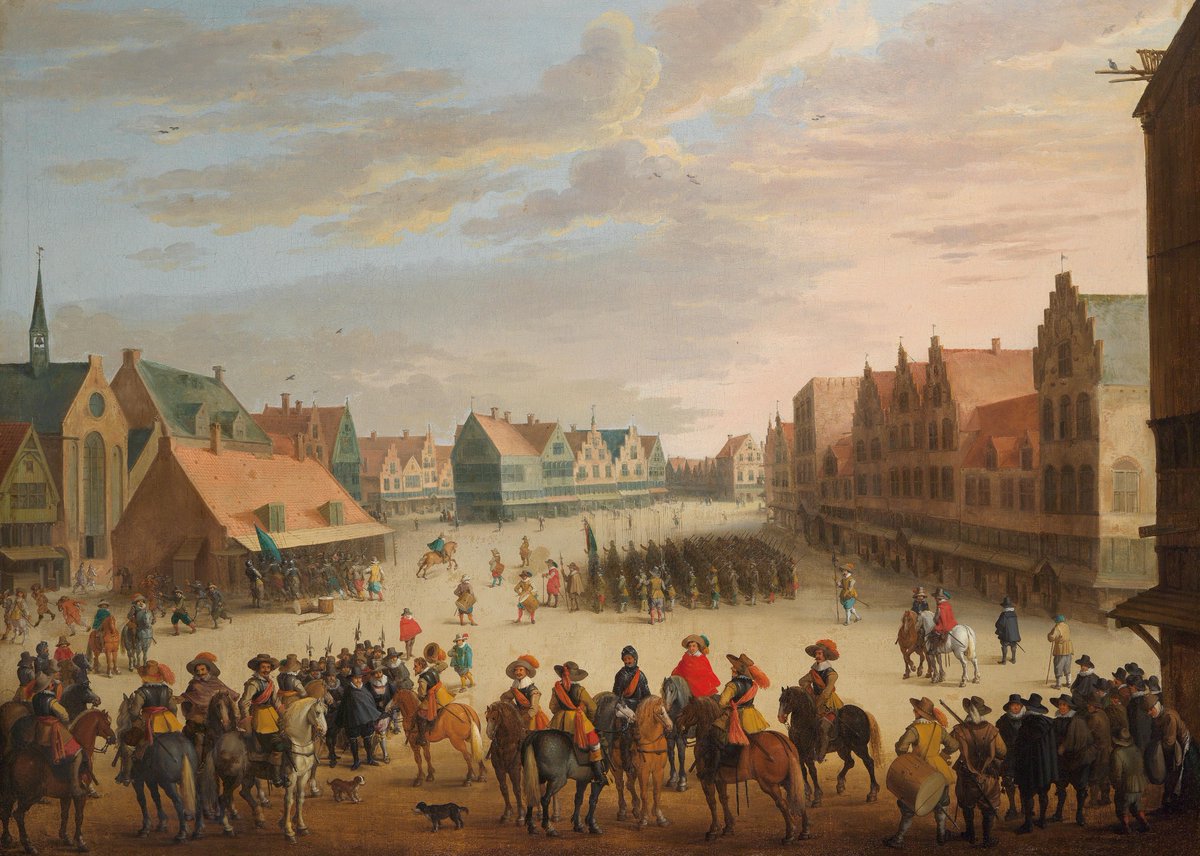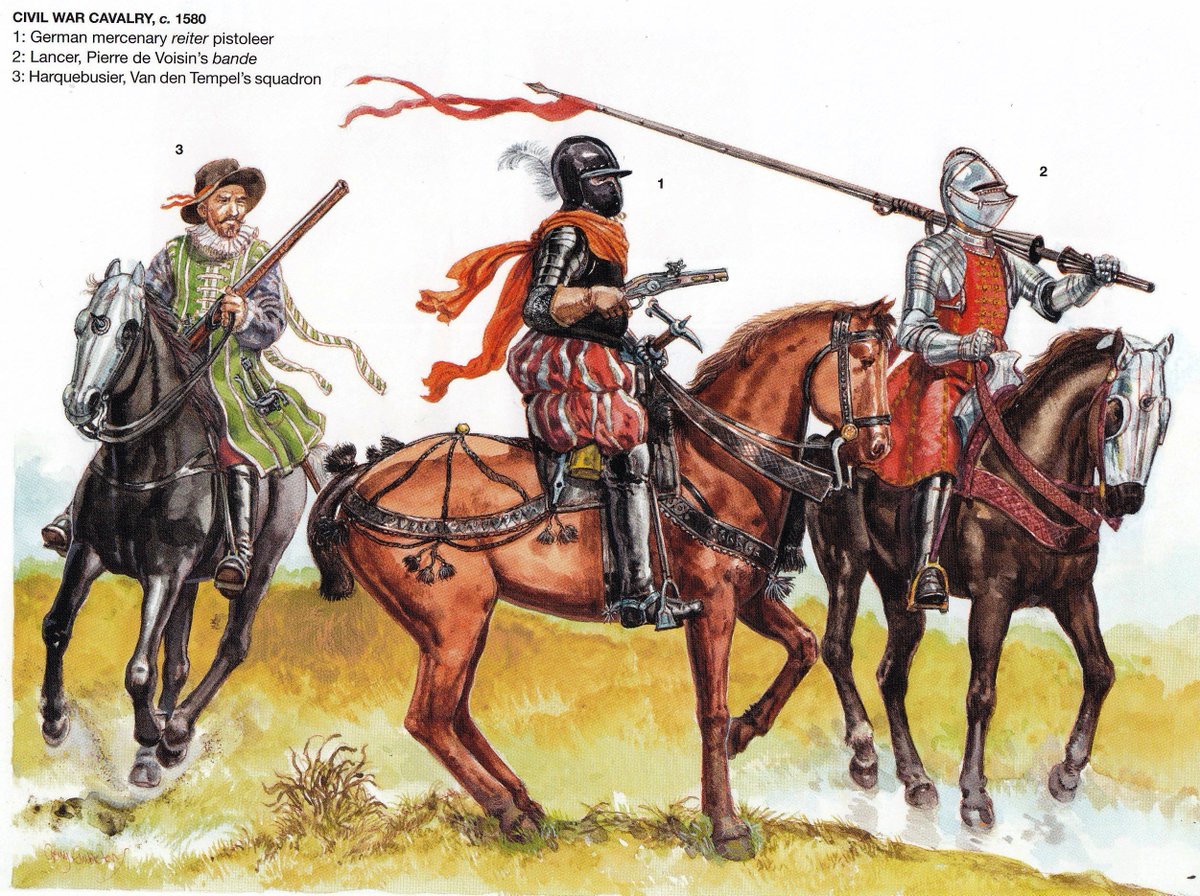
The battle of Nieuwpoort, 1600.
A spectacular battle on the beach during the Eighty Years' War!
But the hard fought Dutch triumph over the Spanish that day was a result of clever military reforms.
A new power was rising!
Let's explore the Dutch military evolution.
THREAD

A spectacular battle on the beach during the Eighty Years' War!
But the hard fought Dutch triumph over the Spanish that day was a result of clever military reforms.
A new power was rising!
Let's explore the Dutch military evolution.
THREAD


The Dutch revolt against the Spanish Empire would lead to an 80 years long conflict from 1568 to 1648.
It would give birth to the mighty Dutch Republic.
But most importantly it would be an important step in evolution of warfare as the constant war forced both sides to evolve.

It would give birth to the mighty Dutch Republic.
But most importantly it would be an important step in evolution of warfare as the constant war forced both sides to evolve.


The Dutch revolt effectively split the territory into Dutch Republic and Spanish Netherlands. The war then revolved around trying to conquer the key strategic fortresses and turned into a grueling and costly prolonged bloodbath between two powerful states with huge resources. 

What led to many improvements was the fact that both sides needed to have a standing army. This differed from medieval practice of raising an army on a campaign-to-campaign basis and led to a more modernized and professionalized army that had to be paid and drilled. 

While we talk about the Spanish and the Dutch for practical reasons, both armies were multiethnic and used mercenaries from all over Europe. The massive Spanish Army of Flanders had Italians, Germans, Walloons, English and Irish serving in its ranks. It was a true imperial army. 

At the same time the Dutch States Army employed German, French, Scottish and English mercenaries. A republican army in name, it was really an imperial mercenary army.
Both of these two armies were colossal in size for the time and required a huge amount of money to sustain them.
Both of these two armies were colossal in size for the time and required a huge amount of money to sustain them.

Logistically, it was more difficult for the Spanish to sustain their efforts. First, the were far from home and needed to sustain the long "Spanish road" to transport their Spanish and Italian troops and resources to the Spanish Netherlands. They were also surrounded by enemies. 



Also Spain had bankrupted many times and the Spanish were notoriously late on paying their soldiers in the Spanish Netherlands, leading to mutinies, indiscipline and general discontent.
Meanwhile the Dutch war machine was more efficient when it came to logistics.
Meanwhile the Dutch war machine was more efficient when it came to logistics.

However the Dutch still had to face the famed Spanish tercios who were the masters of the pike and shot infantry warfare. They needed more than just good logistics. Faced with such intimidating opponent, the Dutch started exploring military tactics and innovations. 

The pike and shot tactic revolved around large squares of pikemen protecting the units armed with guns from cavalry charges and other infantry, therefore a mixture of "pike" and "shot" units. The Spanish excelled at it because of their great value in infantry melees with pikes. 

But pike and shot warfare was constantly evolving over the 16th century. The evolution went from overwhelmingly using pike, to using shot more and more. So the ratio between pike and shot was constantly changing to involve more of the latter. 

The Dutch were lucky to have one of the brilliant minds of the era, Maurice of Nassau, as the powerful stadtholder and military leader. Him and his cousins would serve the Dutch cause with distinction and he would modernize the army into a formidable force to fight the Spanish! 

Under Maurice of Nassau, the Dutch were becoming the main reformers of the pike and shot tactics. By 1600 he increased the number of shot units in Dutch army so that the ratio between pike and shot became 1:1. His shot units were all musketeers too, removing the caliver guns. 

Furthermore Maurice of Nassau would change the basic formation of infantry into smaller units in checkerboard formation as opposed to large tercio blocks. This way his army became more maneuverable. Crucially, he mixed in cavalry units in between infantry regiments. 

It was cavalry that would give the crucial advantage to the Dutch over the Spanish.
While the Spanish tercio were following the developments as well and began using increasingly more musketeer units, the Spanish cavalry was inferior and was very poorly integrated with infantry.
While the Spanish tercio were following the developments as well and began using increasingly more musketeer units, the Spanish cavalry was inferior and was very poorly integrated with infantry.

Maurice of Nassau reformed the Dutch cavalry so it would include mostly cuirassiers and harquebusiers while dramatically decreasing the number of lancers.
Lancers needed more training to be effective and were becoming an increasingly archaic military unit.
Lancers needed more training to be effective and were becoming an increasingly archaic military unit.

The heavily armored cuirassiers with pistols could be trained in just mere months and could also engage in melees with enemy cavalry. They were a more versatile and cheaper unit. Harquebusiers were a lightly armored skirmisher cavalry armed with carbines. They added mobility. 

Everything was orientated towards simplicity and effectiveness in the Dutch army. Maurice of Nassau gradually completely disbanded the archaic units like halberdiers and sword and buckler men, preferring only pikes and muskets. 

But most important were the drills and discipline that Nassau enforced. He took advantage of Dutch having a standing army and used the time away from campaigns to drill his soldiers. Drilling with firearms was crucial as Nassau wanted a constant fire from his troops in battles. 

Muskets in late 16th century still needed a long time to reload and because of this Maurice of Nassau developed a tactic called the countermarch where the musketeers would retreat back in order after firing a volley to reload while other musketeers would fire in the process. 

Despite developing the Dutch army into such a formidable force, Maurice of Nassau avoided open battles and preferred sieges. He saw open pitched battles as an unnecessary risk where he felt much more could be lost than gained. Yet at Nieuwpoort he was forced into open battle. 

The battle of Nieuwpoort happened during a campaign to take over the important port of Dunkirk deep into Spanish territory. Nassau was against this campaign from beginning yet the Dutch republic government persisted and he eventually found himself cornered and forced to fight. 

Maurice of Nassau would face the Spanish Army at Nieuwpoort on the beach. This would be one of the rare big open battles of the Eighty Years' War. The Spanish were led by the governor of the Spanish Netherlands Archduke Albert himself. Both armies were numerically similar. 

The Dutch who had around 10000 infantry and 1500 cavalry took a defensive position on a stretch of dunes along the beach. Nassau employed his wide formation of many maneuverable smaller units while the Spanish with around 8000 infantry employed their large tercio squares. 

The terrain was tricky and dunes worked in the favor of Dutch formation as they forced the Spanish to split up their units as tried to take them one by one while Dutch musketeers constantly shot at them from neighboring ones with a disciplined counter-march. 

Nevertheless the Spanish forced a brutal push of pike against the elite Frisian units headed by the experienced English commander in Dutch service Francis Vere.
The Spanish were able to push back the left wing of Dutch infantry back significantly.
The Spanish were able to push back the left wing of Dutch infantry back significantly.

But it was the cavalry that would win the day for the Dutch. Maurice of Nassau employed his cavalry well and kept some extra units in reserve. Eventually the Spanish cavalry would be completely routed by the Dutch cavalry. 

The battle was bloody with big casualties on both sides. However the tired Spanish would have more casualties and their broken army was forced to retreat after relentless pressure from Dutch cavalry and musketeers. Around 3000-4000 Spanish soldiers died that day. 

This battle was most of all an important morale victory for the Dutch that was used greatly for propaganda.
However the actual military value was not great since the Dutch could not exploit this triumph in any meaningful sense, therefore proving Nassau's initial doubts.
However the actual military value was not great since the Dutch could not exploit this triumph in any meaningful sense, therefore proving Nassau's initial doubts.

But the true value of this battle was that it proved that the military reforms of Nassau were working. The Dutch could at the very least hold their ground against the Spanish in an open battle. Nassau's tactics would become studied and emulated elsewhere in Europe. 

• • •
Missing some Tweet in this thread? You can try to
force a refresh
































